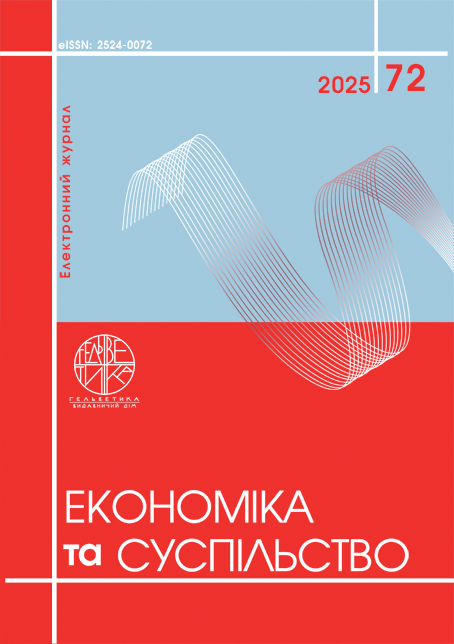INNOVATIVE APPROACHES TO MANAGING BUDGETARY RISKS IN THE CONTEXT OF DIGITAL TRANSFORMATION OF THE FINANCIAL SYSTEM
Abstract
The features of budgetary risk management in the context of digital transformation of the financial system are studied and the possibilities of improving this process through the use of innovative technologies are considered. It is established that traditional methods of risk assessment based on retrospective analysis do not provide the necessary accuracy and efficiency in identifying financial threats. It has been found that the integration of artificial intelligence, automated monitoring systems, machine learning and blockchain technologies contributes to more effective control over budget operations and minimises risks. The purpose of the study is to systematically analyse the key aspects of budget risk management in the context of digitalisation and to develop scientifically sound recommendations on the use of modern technologies to improve its efficiency. The article uses a systematic approach to assess the impact of digital technologies on budget risk management, a comparative analysis of traditional and digital risk management methods, and a structural and functional approach to classify modern monitoring and forecasting tools. The main problems that complicate the introduction of digital technologies in budget management are identified, including regulatory barriers, insufficient integration of information systems, limited funding for digitalisation, and technological challenges related to cyber threats. It is proved that effective budget risk management is possible with the creation of a single digital platform for monitoring financial flows, updating regulations and applying analytical systems based on big data. The practical value of the work lies in the development of recommendations for the introduction of digital technologies into the budget control system, which will help to increase the transparency of the budget process and minimise financial threats. Prospects for further research are related to improving the methodological apparatus for assessing budget risks and creating adaptive forecasting algorithms based on artificial intelligence.
References
Гончарук Я. М., Жук І. І., Семенів Л. В., Осадчук М. М. Use of financial technologies in state management of cash flows and budgetary policy of Ukraine. Наукові записки Львівського університету бізнесу та права. Вип. 44. С. 45-55. URL: https://nzlubp.org.ua/index.php/journal/article/view/1524 (дата звернення: 16.03.2025).
Барич-Тіновська Л. П., Дурман О. Л. Сучасні цифрові інструменти підвищення прозорості та ефективності використання публічних коштів. Таврійський науковий вісник. Серія: Публічне управління та адміністрування. Вип. 3. С. 14-22. DOI: https://doi.org/10.32851/tnv-pub.2022.3.2 (дата звернення: 16.03.2025).
Clarke A. Digital government units: what are they, and what do they mean for digital era public management renewal? International Public Management Journal. Vol. 23, № 3. P. 358-379. DOI: https://doi.org/10.1080/10967494.2019.1686447 (date of access: 16.03.2025).
Захаркіна Л. С., Захаркін О. О., Сокол Л. В. Цифрові інструменти управління фінансовими ризиками бізнесу в умовах воєнного стану. Актуальні питання економічних наук. Вип. 5. DOI: https://doi.org/10.5281/zenodo.14190965 (дата звернення: 16.03.2025).
Skoryk M., Bohdan S. Risk management tools in the system of public financial control. Ефективна економіка. Вип. 5. URL: http://www.economy.nayka.com.ua/?op=1&z=7932. DOI: 10.32702/2307-2105-2020.5.71 (дата звернення: 16.03.2025).
Bracci E., Mouhcine T., Rana T., Wickramasinghe D. Risk management and management accounting control systems in public sector organizations: a systematic literature review. Public Money & Management. Vol. 42, № 6. P. 395-402. DOI: https://doi.org/10.1080/09540962.2021.1963071 (date of access: 16.03.2025).
Третяк Д., Мєдвєдкова Н. Управління фіскальними ризиками державного бюджету України в умовах війни. Вісник Київського національного університету імені Тараса Шевченка. Вип. 4, № 221. С. 64-73. DOI: https://doi.org/10.17721/1728-2667.2022/221-4/9 (дата звернення: 16.03.2025).
Криниця С. Сучасні тренди розвитку цифрових технологій та їх вплив на публічні фінанси. Збірник наукових праць Державного податкового університету. Вип. 2. С. 82-120. DOI: https://doi.org/10.33244/2617-5940.2.2023.82-120 (дата звернення: 16.03.2025).
Tohănean D., Buzatu A. I., Baba C. A., Georgescu B. Business model innovation through the use of digital technologies: Managing risks and creating sustainability. Amfiteatru Economic. Vol. 22, № 55. P. 758-774. URL: https://www.ceeol.com/search/article-detail?id=888540 (date of access: 16.03.2025).
Tsindeliani I. A., Proshunin M. M., Sadovskaya T. D., Popkova Zh. G., Davydova M. A., Babayan O. A. Digital transformation of the banking system in the context of sustainable development. Journal of Money Laundering Control. Vol. 25, № 1. P. 165-180. DOI: https://doi.org/10.1108/jmlc-02-2021-0011/full/html (date of access: 16.03.2025).
Challoumis C. The evolution of financial systems – AI’s role in reshaping money management. XVI International Scientific Conference (Tallinn. Estonia. 17-18.10.2024). 2024. P. 128-151. URL: https://conference-w.com/wp-content/uploads/2024/10/EST.T-1718102024.pdf#page=129 (date of access: 16.03.2025).
Yashina N. I., Makarova S. D., Kashina O. I., Kuznetsov V. P., Romanovskaya E. V. Methodical Approaches to Analysis of Performance of Budgetary Obligations on the Basis of the Risk-Oriented Approach. In: Popkova E., Sergi B. (eds) Digital Economy: Complexity and Variety vs. Rationality. ISC 2019. Lecture Notes in Networks and Systems. Vol. 87. Springer, Cham. P. 662-669. DOI: https://doi.org/10.1007/978-3-030-29586-8_77 (date of access: 16.03.2025).
ІBM Watson AI: website. 2025. URL: https://www.ibm.com/watson (date of access: 16.03.2025).
Google AI: website. 2025. URL: https://ai.google (date of access: 16.03.2025).
SAS Risk Management: website. 2025. URL: https://www.sas.com/en_us/solutions/risk-management.html (date of access: 16.03.2025).
RapidMiner: website. 2025. URL: https://rapidminer.com (date of access: 16.03.2025).
Apache Hadoop: website. 2025. URL: https://hadoop.apache.org (date of access: 16.03.2025).
Cloudera: website. 2025. URL: https://www.cloudera.com (date of access: 16.03.2025).
Ethereum Smart Contracts: website. 2025. URL: https://ethereum.org/en/developers/docs/smart-contracts/ (date of access: 16.03.2025).
Hyperledger Fabric: website. 2025. URL: https://www.hyperledger.org/use/fabric (date of access: 16.03.2025).
Microsoft Azure Government: website. 2025. URL: https://azure.microsoft.com/en-us/solutions/government/ (date of access: 16.03.2025).
Amazon AWS GovCloud: website. 2025. URL: https://aws.amazon.com/govcloud-us/ (date of access: 16.03.2025).
Tableau: website. 2025. URL: https://www.tableau.com (date of access: 16.03.2025).
Power BI: website. 2025. URL: https://powerbi.microsoft.com (date of access: 16.03.2025).
Qlik Sense: website. 2025. URL: https://www.qlik.com/us/products/qlik-sense (date of access: 16.03.2025).
Єдиний веб-портал використання публічних коштів: вебсайт. 2025. URL: https://spending.gov.ua (дата звернення: 16.03.2025).
ProZorro: вебсайт. 2025. URL: https://prozorro.gov.ua (дата звернення: 16.03.2025).
Система електронної взаємодії «Трембіта»: вебсайт. 2025. URL: https://trembita.gov.ua (дата звернення: 16.03.2025).
Goncharuk, Ya. M., Zhuk, I. I., Semeniv, L. V., & Osadchuk, M. M. (2025). Use of financial technologies in state management of cash flows and budgetary policy of Ukraine. Naukovi zapysky Lvivskoho universytetu biznesu ta prava, vol. 44, pp. 45-55. URL: https://nzlubp.org.ua/index.php/journal/article/view/1524 (in Ukrainian).
Barych-Tinovska, L. P., & Durman, O. L. (2022). Suchasni tsyfrovi instrumenty pidvyshchennia prozorosti ta efektyvnosti vykorystannia publichnykh koshtiv [Modern digital tools for increasing transparency and efficiency in the use of public funds]. Tavriiskyi naukovyi visnyk. Seriia: Publichne upravlinnia ta administruvannia, vol. 3, pp. 14-22. DOI: https://doi.org/10.32851/tnv-pub.2022.3.2 (in Ukrainian).
Clarke, A. (2020). Digital government units: What are they, and what do they mean for digital era public management renewal? International Public Management Journal, vol. 23, no. 3, pp. 358-379. DOI: https://doi.org/10.1080/10967494.2019.1686447.
Zakharkina, L. S., Zakharkin, O. O., & Sokol, L. V. (2024). Tsyfrovi instrumenty upravlinnia finansovymy ryzykamy biznesu v umovakh voiennoho stanu [Digital tools for managing financial risks of business during wartime]. Aktualni pytannia ekonomichnykh nauk, vol. 5. DOI: https://doi.org/10.5281/zenodo.14190965 (in Ukrainian).
Skoryk, M., & Bohdan, S. (2020). Risk management tools in the system of public financial control. Efektyvna ekonomika, vol. 5. URL: http://www.economy.nayka.com.ua/?op=1&z=7932. DOI: 10.32702/2307-2105-2020.5.71.
Bracci, E., Mouhcine, T., Rana, T., & Wickramasinghe, D. (2022). Risk management and management accounting control systems in public sector organizations: A systematic literature review. Public Money & Management, vol. 42, no. 6, pp. 395-402. DOI: https://doi.org/10.1080/09540962.2021.1963071.
Tretiak, D., & Miedviedkova, N. (2022). Upravlinnia fiskalnymy ryzykamy derzhavnoho biudzhetu Ukrainy v umovakh viiny [Fiscal risk management of Ukraine's state budget under war conditions]. Bulletin of Taras Shevchenko National University of Kyiv. Economics, vol. 4, no. 221, pp. 64-73. DOI: https://doi.org/10.17721/1728-2667.2022/221-4/9 (in Ukrainian).
Krynytsia, S. (2023). Suchasni trendy rozvytku tsyfrovykh tekhnolohii ta yikh vplyv na publichni finansy [Modern trends in the development of digital technologies and their impact on public finance]. Zbirnyk naukovykh prats Derzhavnoho podatkovoho universytetu, vol. 2, pp. 82-120. DOI: https://doi.org/10.33244/2617-5940.2.2023.82-120 (in Ukrainian).
Tohănean, D., Buzatu, A. I., Baba, C. A., & Georgescu, B. (2020). Business model innovation through the use of digital technologies: Managing risks and creating sustainability. Amfiteatru Economic, vol. 22, no. 55, pp. 758-774. URL: https://www.ceeol.com/search/article-detail?id=888540.
Tsindeliani, I. A., Proshunin, M. M., Sadovskaya, T. D., Popkova, Zh. G., Davydova, M. A., & Babayan, O. A. (2022). Digital transformation of the banking system in the context of sustainable development. Journal of Money Laundering Control, vol. 25, no. 1, pp. 165-180. DOI: https://doi.org/10.1108/jmlc-02-2021-0011/full/html.
Challoumis, C. (2024). The evolution of financial systems - AI’s role in reshaping money management. XVI International Scientific Conference (Tallinn, Estonia, 17-18.10.2024), pp. 128-151. URL: https://conference-w.com/wp-content/uploads/2024/10/EST.T-1718102024.pdf#page=129.
Yashina, N. I., Makarova, S. D., Kashina, O. I., Kuznetsov, V. P., & Romanovskaya, E. V. (2020). Methodical approaches to analysis of performance of budgetary obligations on the basis of the risk-oriented approach. In: Popkova, E., & Sergi, B. (Eds.) Digital Economy: Complexity and Variety vs. Rationality. ISC 2019. Lecture Notes in Networks and Systems, vol. 87, pp. 662-669. Springer, Cham. DOI: https://doi.org/10.1007/978-3-030-29586-8_77.
IBM Watson AI (2025). IBM: website. Available at: https://www.ibm.com/watson (date of access: 16.03.2025).
Google AI (2025). Google: website. Available at: https://ai.google (date of access: 16.03.2025).
SAS Risk Management (2025). SAS: website. Available at: https://www.sas.com/en_us/solutions/risk-management.html (date of access: 16.03.2025).
RapidMiner (2025). RapidMiner: website. Available at: https://rapidminer.com (date of access: 16.03.2025).
Apache Hadoop (2025). Apache: website. Available at: https://hadoop.apache.org (date of access: 16.03.2025).
Cloudera (2025). Cloudera: website. Available at: https://www.cloudera.com (date of access: 16.03.2025).
Ethereum Smart Contracts (2025). Ethereum: website. Available at: https://ethereum.org/en/developers/docs/smart-contracts/ (date of access: 16.03.2025).
Hyperledger Fabric (2025). Hyperledger: website. Available at: https://www.hyperledger.org/use/fabric (date of access: 16.03.2025).
Microsoft Azure Government (2025). Microsoft Azure: website. Available at: https://azure.microsoft.com/en-us/solutions/government/ (date of access: 16.03.2025).
Amazon AWS GovCloud (2025). Amazon AWS: website. Available at: https://aws.amazon.com/govcloud-us/ (date of access: 16.03.2025).
Tableau (2025). Tableau: website. Available at: https://www.tableau.com (date of access: 16.03.2025).
Power BI (2025). Microsoft Power BI: website. Available at: https://powerbi.microsoft.com (date of access: 16.03.2025).
Qlik Sense (2025). Qlik: website. Available at: https://www.qlik.com/us/products/qlik-sense (date of access: 16.03.2025).
E-data. Yedynyi veb-portal vykorystannia publichnykh koshtiv [Unified web portal for the use of public funds] (2025). E-data: website. Available at: https://spending.gov.ua (in Ukrainian).
ProZorro. Systema publichnykh zakupivel [Public e-procurement system] (2025). ProZorro: website. Available at: https://prozorro.gov.ua (in Ukrainian).
Trembita. Systema elektronnoi vzaiemodii [Trembita electronic interaction system] (2025). Trembita: website. Available at: https://trembita.gov.ua (in Ukrainian).

This work is licensed under a Creative Commons Attribution 4.0 International License.


